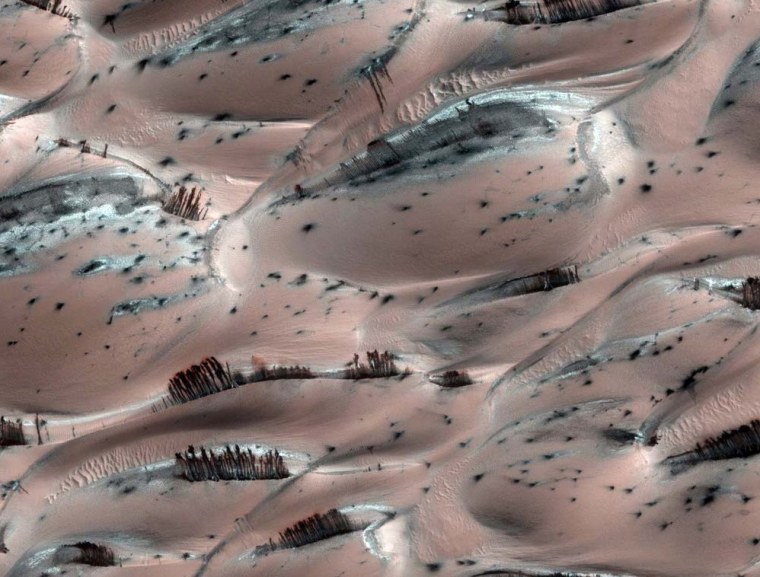Naturally erupting dust clouds on Mars are creating structures that look surprisingly like trees near the planet's north pole. But don't be fooled — it's just an optical illusion, NASA scientists say.
The Martian "trees" are actually dark basaltic sand pushed to the surface of sand dunes by sun-heated solid carbon dioxide ice, or dry ice, sublimating directly into vapor, explained Candy Hansen, a member of NASA's Mars Reconnaissance Orbiter (MRO) team at the University of Arizona.
The sand dunes form a nearly complete ring around Mars' north pole and are covered by a thin layer of reddish Martian dust and patches of dry ice. To date, there is no firm evidence of any type of Martian biology, past or present, plant or otherwise.
In the Martian spring, the sun warms the ice, causing it to sublimate directly into vapor, and the resulting gas dislodges surrounding dust and sand particles.
"What we think is happening is that the dark sand is sliding down the bright frosted portion of the dune," Hansen told SPACE.com.
The image, taken by MRO's High Resolution Imaging Science Experiment (HiRISE) camera, is part of a series of Martian images appearing in a special issue of the journal Icarus this month.
The Martian illusion is not the first to capture the imaginations of people on Earth.
In 1976, a photograph of a rock formation on Mars beamed to Earth by NASA's Viking 1 orbiter looked to many like a face carved in the Martian surface. The Face on Mars photo's legacy has survived to this day, even after additional observations by more advanced spacecraft have revealed it to be a trick of light and shadows.
Since then, other Martian illusions have popped up in images from orbiters and rovers, including an object that resembled a small bunny and a rock that looked like a female figure to some and Bigfoot to others.
The streaks in the new image look as if they are rising up from the sand dunes, but that's an illusion, Hansen said. "You're looking at the slip face of the dune, and where the sand comes to a stop, it forms a sort of scallop-shaped edge at the bottom."
Each dark sand streak can measure up to 164 feet (50 meters) in length.
HiRISE actually caught one of the dust eruptions as they happened.
"If you look closely, you can see this little dust cloud casting a tiny shadow," Hansen said.
